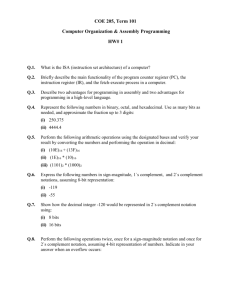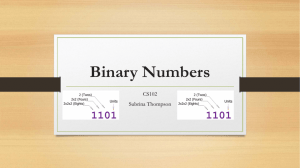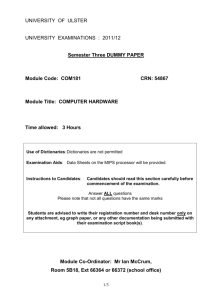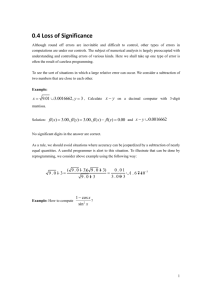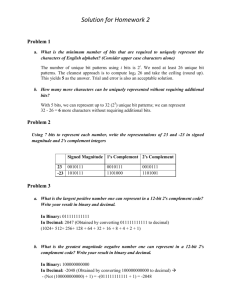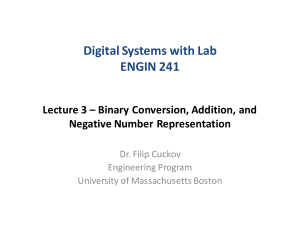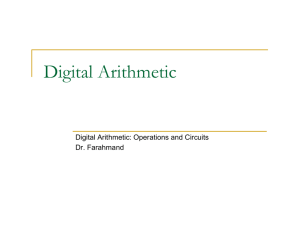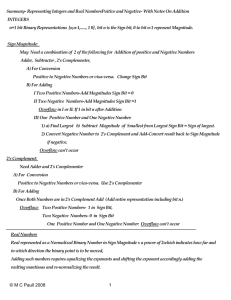doc format
advertisement
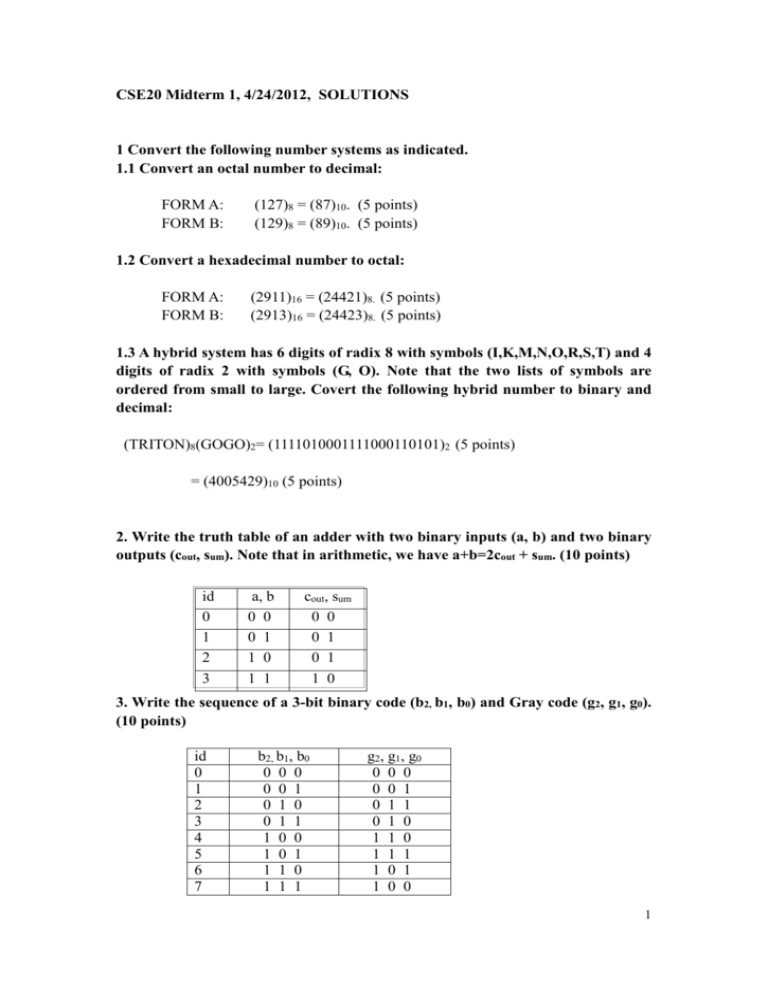
CSE20 Midterm 1, 4/24/2012, SOLUTIONS 1 Convert the following number systems as indicated. 1.1 Convert an octal number to decimal: FORM A: FORM B: (127)8 = (87)10. (5 points) (129)8 = (89)10. (5 points) 1.2 Convert a hexadecimal number to octal: FORM A: FORM B: (2911)16 = (24421)8. (5 points) (2913)16 = (24423)8. (5 points) 1.3 A hybrid system has 6 digits of radix 8 with symbols (I,K,M,N,O,R,S,T) and 4 digits of radix 2 with symbols (G, O). Note that the two lists of symbols are ordered from small to large. Covert the following hybrid number to binary and decimal: (TRITON)8(GOGO)2= (1111010001111000110101)2 (5 points) = (4005429)10 (5 points) 2. Write the truth table of an adder with two binary inputs (a, b) and two binary outputs (cout, sum). Note that in arithmetic, we have a+b=2cout + sum. (10 points) id 0 1 2 3 a, b 0 0 0 1 1 0 1 1 cout, sum 0 0 0 1 0 1 1 0 3. Write the sequence of a 3-bit binary code (b2, b1, b0) and Gray code (g2, g1, g0). (10 points) id 0 1 2 3 4 5 6 7 b2, b1, b0 0 0 0 0 0 1 0 1 0 0 1 1 1 0 0 1 0 1 1 1 0 1 1 1 g2, g1, g0 0 0 0 0 0 1 0 1 1 0 1 0 1 1 0 1 1 1 1 0 1 1 0 0 1 4. The operation of one’s complement. 4.1 FORM A Given X = 1810, Y = 2310, covert the numbers into binary and show the operation of X-Y in one’s complement representation. Suppose that the number of bits is n=10. Show the answer with exactly 10 bits. (10 points) X=(0000010010)2 -Y in 1’s compl.= (1111101000)2 X-Y in 1’s compl.=(1111111010)2 4.1 FORM B Given X = 1710, Y = 2110, covert the numbers into binary and show the operation of X-Y in one’s complement representation. Suppose that the number of bits is n=10. Show the answer with exactly 10 bits. (10 points) X=(0000010001)2 -Y in 1’s compl.= (1111101010)2 X-Y in 1’s compl.=(1111111011)2 4.2 Show the flag of overflow in the above case (4.1) and explain if overflow is true or false. (5 points) Overflow is false, as the carry in digits for the bits in position (n) and (n-1) is zero 4.3 In a 4-bit one’s complement number system, find two positive integers A and B so that –A-B overflows. Describe the arithmetic process and show the overflow flag. (10 points) For instance A=(7)10 B=(6)10 n=4 In binary A=(0111)2 B=(0110)2 One's complement of A= -A = (1000)2 One's complement of B= -B = (1001)2 -A-B: 1000 + 1001 = 1_________ 0001 We have a carry of 1, thus Cn is not equal to Cn-1 and overflows occurs 2 5. We have defined and learned the idea of two’s complement for n-bit binary numbers. 5.1 For an n-digit system with base 10, given an integer x>0, define the 10’s complement representation for -x. (5 points) 10n-x 5.2 Show the arithmetic of –x-y where x=12310 and y=32110 with a 7 digit system in 10’s complement representation. (10 points) -x = 107-123 = 9,999,877 -y = 107-321 = 9,999,679 -x-y: 9,999,877 + 9,999,679 = _____________ 9,999,556 (discarding the carry beyond the 7th bit) The magnitude in decimal can be computed to verify the calculations are correct: 107-x-y=107-9,999,556 = 444 which is what one would expect taking the absolute value of -123-321 in decimal 6. Find x in the following equations, where symbol % denotes modulus operation. 6.1 21%4= x. x= 1 (5 points) 6.2 (-21)%5=x. x= 4 (5 points) 6.3 (8x)%11=1 and 0≤x<11. x= 7 (5 points) 6.4 (-5x)%12=1 and 0≤x<12. x= 7 (5 points) 3 7. Given three integers x>y≥0, and d>0, prove that (x-y)%d=(x%dy%d)%d, where % is a modulus operation. (10 points) x%d means that x=q1*d + r1 y%d means that y=q2*d + r2 Substituting into the left side: (x-y)%d → ( (q1*d + r1) - (q2*d + r2) ) % d → ( (q1-q2)*d + (r1-r2) )%d (q1-q2)*d is a multiple of d. Thus, ((q1-q2)*d) % d = 0 Since x=q1*d + r1 and y=q2*d + r2, r1 = x%d and r2= y%d Substituting in the last step of the expression for the left side we have (0 + ( x%d - y%d) ) %d that is (x%d-y%d)%d which is exactly the right side 4

